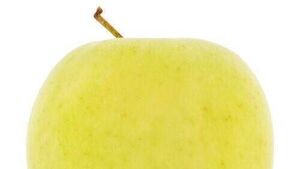Brian Kaller: Why apples are a ‘Golden Delicious’ fruit

A Golden Delicious Apple
AT some point in your childhood, I hope, you ate an apple and hit upon the idea of planting the seeds. Most such experiments stop at the paper-cup stage, but if your tree survived long enough to bear fruit, you probably noticed something strange: the seeds from that Golden Delicious apple do not necessarily grow into a Golden Delicious apple tree.
Seeds come from flowers pollinated with another tree’s DNA, and while the apple’s fruit is determined by what kind of apple tree it is, but the seeds inside are shaped by whatever pollen came to the flower. If the bee that pollinated that Golden Delicious tree, way back when, had been to a crab-apple tree just before, then that Golden Delicious apple contains seeds that are part crab-apple. And since there are so many wild and domesticated apples around us, and bees need to make their appointed rounds, it’s quite difficult to grow purebred apples – and many other fruits – from seeds.
Even if you succeed in growing the fruit you want, it doesn’t necessarily come on the tree you want. You want a certain size of tree, suited for your climate and resistant to disease. With fruits you want a certain size, variety and flavour, and the two don’t often come in the same package.
Each plant variety has strengths and limitations that other varieties do not, just as a golden retriever dog has advantages and limitations that their wild wolf cousins do not. Of course, you can’t simply cut off a dog’s head and plant it onto the body of a wolf, getting a healthy but friendly Franken-dog. With trees, though, you can something surprisingly close to that.
It’s called grafting, and it dates back to ancient times, and today is practiced on a vast commercial scale; when you eat fruit, it was almost certainly from a grafted tree.
If you want to graft a tree the wrong way, do what I did the first time: let the knife slip the wrong way, cut your thumb almost in half, and spend a night in the emergency room. To graft a tree the right way, however, you take a root and stem of one kind of tree for your “stock,” the base of your Franken-tree. You could use a hardy wild variety of crab-apple, or more commonly these days, one of many varieties bred just to be root-stock for grafts. The stock determines what the size and shape of the tree will be – if you use the bottom of a dwarf tree sapling as your stock, you will end up with a dwarf-sized tree.
Then you take a one-year-old cutting, from the previous year’s growth, for your “scion” – again, a Golden Delicious scion if you want Golden Delicious fruit. The tree that grows from a successful grafting will have the best of both worlds; the size and shape of your root-stock variety, but yielding the fruit from your scion variety. It’s best to graft in winter or spring, when the trees are as dormant as possible – the people at Seed Savers say they cut scions in December, store them in sand in cool dry place, and graft them in February or March.
Apples are the fruit most commonly grafted, but you can graft pears, plums, cherries or many other fruit. Amazingly, you can even interchange certain species – stone fruit like plums, cherries and peaches are interchangeable, and you could, in theory, attach them all to one “fruit cocktail” tree. The good people at Seed Savers, County Clare, Ireland, even grow pears from their hawthorn tree.
Nor are you limited to one scion; in theory, you can attach as many scions as your root-stock tree has branches. You can even attach multiple kinds of apple; one man in Britain has grown a single tree, planted 25 years ago, and attached 250 separate scions onto it, making it the only tree in the world to yield that many kinds of fruit.
If you want to try grafting yourself, it’s best to take a course or talk to an expert first, or at least look at a lot more detailed information in books and the Internet; gardening centres around you might have courses available. Once you get it right, though, you can start experimenting with turning a single tree into an orchard.





